by Paula Manstetten
In the 1720s, an Anglican society in London printed a staggering 6,000 Psalters and 10,000 New Testaments in Arabic with the aim of distributing them among the Christians of the Middle East.
The Society for Promoting Christian Knowledge (SPCK) had been founded in 1699 to promote Protestant missions, support persecuted Protestants abroad, and spread Christian education. Over the years, it became involved in numerous endeavours to print religious texts in foreign languages. Among these were translations of the New Testament or the whole Bible into Welsh, Modern Greek, and Tamil. This ‘obsession’ with Bible translations had its origins in the Protestant belief that everyone should be able to read the scripture in their own language in order to have direct access to the word of God.[1]
“A Work of great Charity”
The proposal to print the New Testament in Arabic was first brought before the SPCK in the spring of 1720 (the idea to print the Psalter was added later). The Society asked a range of individuals to give their views on the benefits and viability of the project, among them several former chaplains of the Levant Company and the East India Company. To raise funds, the SPCK published several of their letters, which provide some insights into how the Society chose to present its motivations to potential donors.
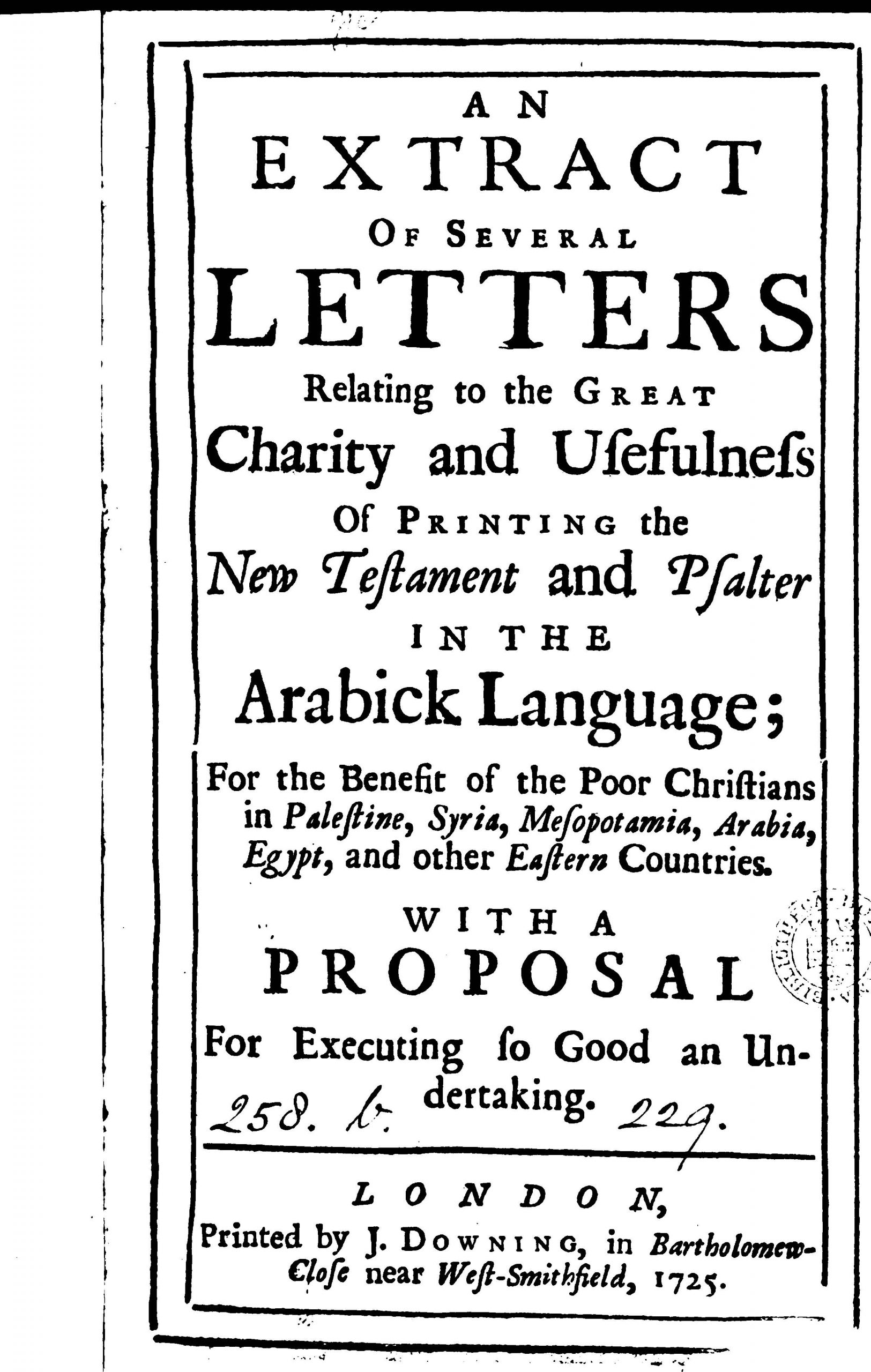
The project’s explicit aim was to “preserve and propagate the Christian Faith among our Brethren in Syria, Palestine, Arabia, and other Eastern Countries from whence We first received it”. Thus stated an expression of support signed by Anglican bishops and archbishops, printed on the first pages of the 1725 reprint of the letter collection.
The letters that followed portrayed the “poor Christians of the Eastern Nations” as having no access to the Bible except for what they might hear at church. “Ignorance, and Corruptions, and Superstitions” were widespread because they could not afford expensive manuscripts or get hold of the scarce printed editions of the Bible. They lived in “unhappy Darkness for want of Copies of the New Testament”. The SPCK’s plan to distribute the Scripture in Arabic, the letters claimed, would be “a Work of great Charity” and a “pious undertaking”.[2]
It was no doubt a conscious choice that the collection was headed by a particularly long and enthusiastic letter by a Melkite Christian from Damascus, Solomon Negri, who lived in London at the time – someone who hailed from one of the Eastern Christian communities the SPCK was hoping to target. Negri (ca. 1665–1727) had travelled from Syria to Paris aged eighteen at the behest of Jesuit missionaries. Over the years, he had worked for the Lutheran Pietists in Halle, with whom the SPCK stood in close contact, as well as for the missionary arm of the Catholic Church in Rome (the Congregatio de Propaganda Fide). Negri could not only claim to have insider knowledge of the Christians of the Middle East – he was also well acquainted with the attempts of Protestant and Catholic missionary organisations in Europe to produce Arabic translations.[3]
Figure 2: First and second page of Negri’s letter in the 1725 edition of “An Extract of Several Letters”. Source: https://books.google.de/books?id=hvgBAAAAQAAJ&printsec=frontcover&hl=de#v=onepage&q&f=false
In his letter, Negri spoke strongly in favour of the project, pointed to the widespread use of Arabic in the Middle East, and made specific suggestions for the best course of action. He also offered a critical assessment of previous Arabic Bible editions printed in Europe: these were too rare and expensive (the 1591 Medici Press edition), full of mistakes (Thomas Erpenius’s 1616 edition; the 1671 Propaganda Fide edition), or had an inconvenient size (the 1650s London Polyglot Bible).[4] Negri’s endorsement of the SPCK’s idea had probably more pragmatic than religious reasons: in the following years, working for the Arabic Bible project became one of his main sources of income.
How will the Eastern Christians react – and how the Catholic missionaries?
What the SPCK omitted from the printed letters were the concerns some of its correspondents had voiced – and which proved to be not unfounded. A former chaplain of the Levant Company warned the Society not to give the impression that the project was meant as “an Assistance to the poor Greek Church; or an Endeavour to inform and enlighten Them”. In his view, the Christians of the Middle East had “very Magnificent Notions of themselves”; they would regard it “a Disgrace to the people of the East, those Antient Nations of the Earth, to learn any thing from so upstart a Race, as (in reality) they consider us in the Western parts of the World to be.”[5]
Another former chaplain of the Levant Company feared that the Roman Catholic missionaries who had established themselves in Syria since the sixteenth century would “use their utmost Endeavours to Obstruct, Frustrate and Disappoint” the distribution of the texts.[6] To avoid raising the suspicions of these missionaries, the SPCK decided to print their Arabic editions without indicating the publisher and place of printing on the title page. Concealing the provenance of translations into Oriental languages was a strategy commonly used by Protestants at the time. In contrast, the Catholic Congregatio de Propaganda Fide had issued its 1671 bilingual Arabic–Latin Bible with a clear indication of its place of origin.

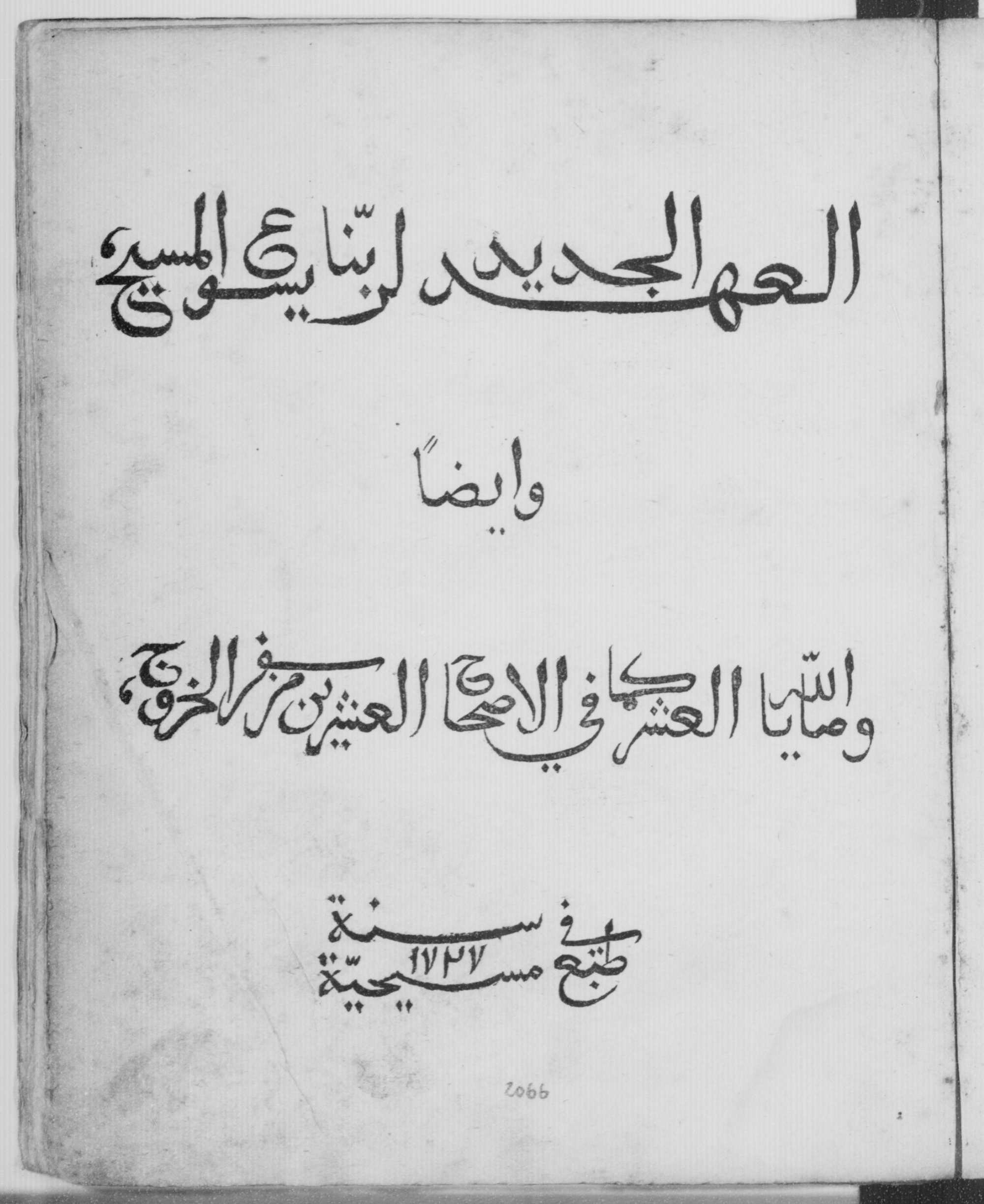

‘Finding’ an Arabic Bible translation for the project
As the SPCK set about the project, the question emerged which Arabic translation of the Bible should be used. Simon Mills has recently uncovered the decisive role of the Aleppo-based English merchant Rowland Sherman (1662–1747) in this regard. (Anyone interested in reading a detailed account of the SPCK’s Bible project should read Mills’s wonderful book A commerce of Knowledge). Sherman had lived in Syria for thirty years. In fact, he had already been working on a revised Arabic translation of the New Testament on his own initiative. He had compared Thomas Erpenius’s edition, the London Polyglot, and the original Greek text, also making use of the commentary tradition. He had enlisted the help of the Greek patriarch of Antioch, Athanasius III Dabbas (1647–1724), and a local Maronite priest for comparing the Arabic text with the Greek and the Latin Vulgate, rectifying ‘mistakes’, and translating some parts anew. As Sherman pointed out in a letter to the SPCK, his approach ensured that local clergymen would “look upon the Work as their own when it should become Publick.”[7] Athanasius, in turn, had already printed an Arabic translation of the Psalter and the Gospels in Aleppo in 1706 – the first books printed in Arabic in the Middle East.[8] Sherman sent these editions and his own manuscripts to London, where they served as the basis of the SPCK’s Arabic texts.
Figure 6 and 7: Title Page and first psalm of the Arabic Psalter printed by Athanasius III Dabbas, Aleppo 1706. Source: Wien, Österreichische Nationalbibliothek, Sammlung von Handschriften und alten Drucken (ALT), 2.J.7. https://onb.digital/result/10268984
Not only in Aleppo but also in London, Arab Christians played an important part in the project. Solomon Negri and the Aleppan Carolus Rali/Theocharis Dadichi (ca. 1693–1734) attended numerous meetings of the Bible committee, translated further material sent by Sherman from Aleppo, and proofread the translations and the printed sheets. Several English Orientalists served as correctors, among them George Sale (1697–1736), who later became famous as the translator of the Quran into English. While modern library catalogues often name Negri as the sole editor of the SPCK’s Psalter and New Testament, he was just one of many individuals who contributed to the edition.
The pitfalls of printing in Arabic
Printing the Arabic script with movable types was notoriously difficult, and the question of producing an adequate Arabic font troubled the SPCK for years. After enquiring about existing types, such as those used for the London Polyglot, the SPCK decided to cut a new set of smaller types – in order to keep the cost of paper and binding low. Negri, who estimated that around 300 different types would be necessary, regularly visited the workshop of the type-founder William Caslon (1692–1766) to supervise the cutting of the letters.
The minutes of the Arabic Bible committee reveal some of the problems the Society encountered with the font. The clergyman Arthur Bedford (1668–1745), a member of the SPCK who knew Arabic and was closely involved in the project, seems to have been particularly concerned about the aesthetics of the print. At one point, he complained that “the Name of GOD was expres’d by a Character much less than the other Letters, and so disproportionate to others, that it seem’d very unsightly”. Caslon was asked to make a larger one. After the Psalter had already gone into print, Bedford even suggested that a new font should be cut for the New Testament: the smallness of the current letters risked making “the Edition contemptible to Turks and Papists [i.e. Catholics] in those Countries, where Books of Value, and especially the Alcoran, are always written in a larger Character.” The committee decided against his motion.[9]
Another issue was the question of “orthographical notes” or diacritics. In the Arabic script, only consonants and long vowels are represented by letters; supplementary diacritics (tashkīl) can be added to indicate consonant length and short vowels, e.g. when the meaning or grammatical case would remain otherwise ambiguous. Bedford was in favour of using them, pointing out that “the best and finest Alcoran manuscripts” used diacritical marks on all letters, and that this was also the case in the London Polyglot.[10] The Bible committee worried that including diacritics would considerably increase the cost of printing but wondered whether they might “render the text more intelligible to the Common People for whose use the Books are principally designed.”[11] After soliciting opinions from numerous individuals, including Negri and Dadichi, Sherman and his local informants in Aleppo, as well as several scholars of Oriental studies, the SPCK decided to insert some, but not all, diacritics in the New Testament. The Psalter had already been printed without them.
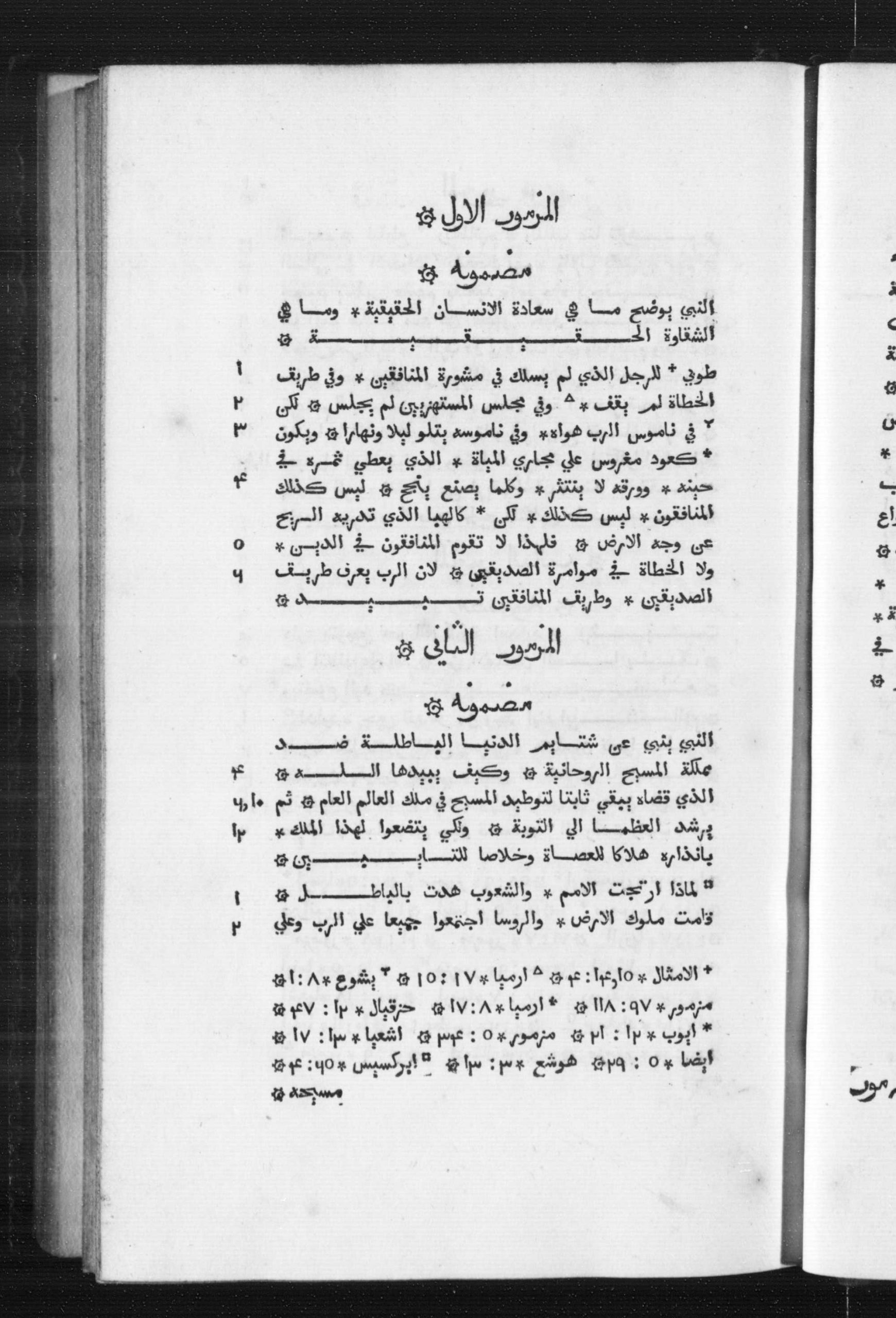
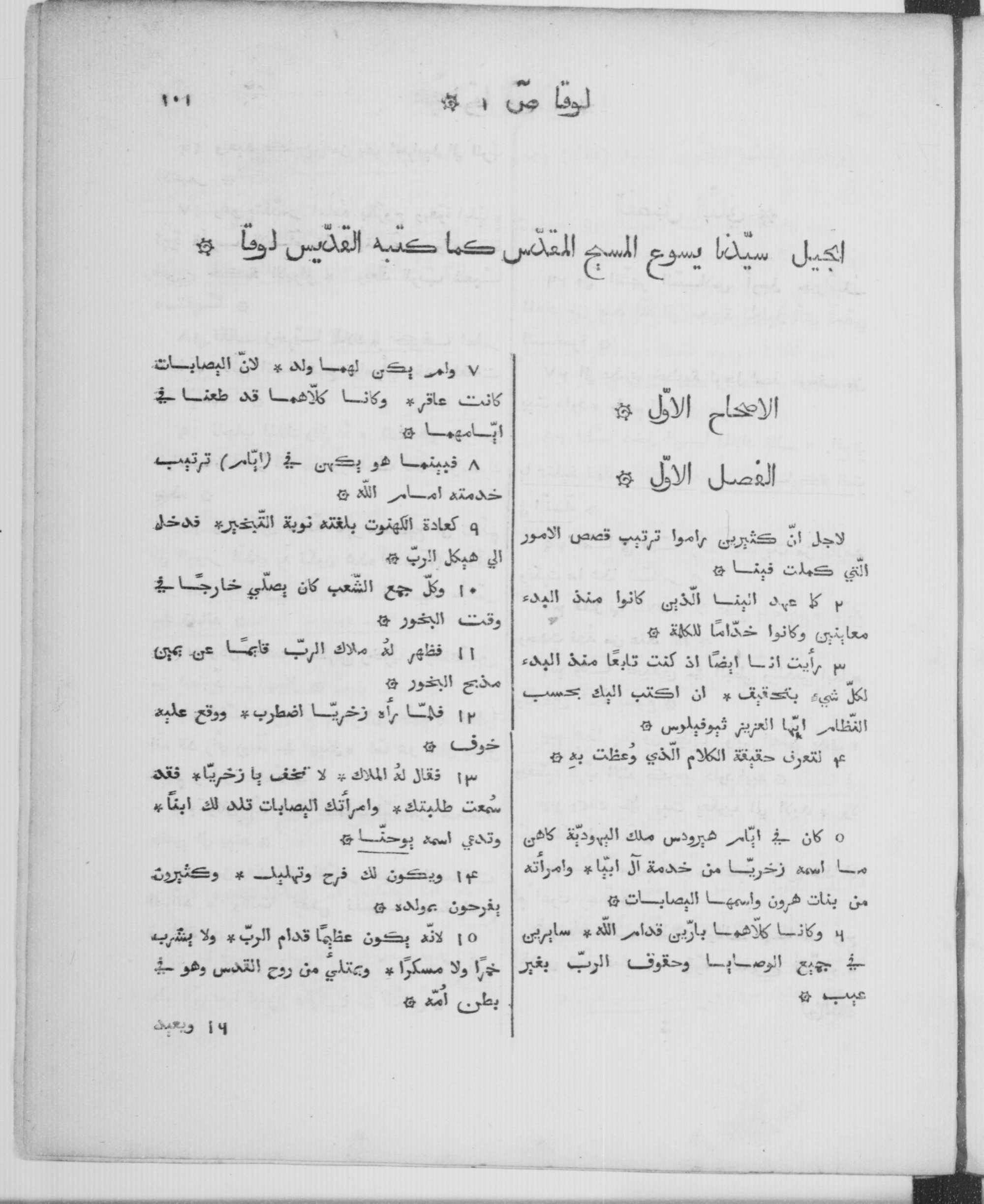
Burned by Catholics and Eastern Christians – but a ‘success’ nonetheless?
The printing of the Psalter and New Testament in Arabic had been conceived in a missionary context, as the SPCK attempted to gain a foothold among the Christians of the Middle East at the expense of its Roman Catholic rivals. When the Psalters and New Testaments were sent to Sherman in Aleppo (on ships of the Levant Company), the shipments also included Arabic translations of some Protestant texts, such as Hugo Grotius’s apologetic work De veritate religionis christianae and 5,000 copies of an Arabic catechism. Sherman distributed the texts in Syria and as far as Cairo but soon encountered difficulties. The Greek patriarch Athanasius, on whose support he had planned to rely, had already died. The books soon met with resistance from Catholic missionaries and from within the Eastern Christian communities: many copies were apparently burned because they had come from ‘heretics’. They were better received in a rather unexpected place: in the Russian garrisons in Narva, where a Lutheran pastor distributed them among Persian Christian prisoners.[12]
Still, back in England, the realisation of the project was a ‘performative act’ of sorts, or, as Mills puts it, one of “self-affirmation”.[13] It had been supported by King George I (who had contributed £500) and numerous Anglican bishops and archbishops. All those involved in its completion probably felt that they had done their best to promote the “Honour of our Country”, the “Honour of the English Reformation”, and ultimately God’s “Honour and Glory”.[14]
Paula Manstetten is a post-doctoral researcher at Bamberg University, Germany. Her research focuses on Oriental studies and Arab Christians in early modern Europe, pre-modern Arabic historiography and biography, and Islamic education. She studied Arabic and Islamic studies and literature in Münster, Berlin, Damascus, and London, and completed her PhD on Ibn ʿAsākir’s twelfth-century History of Damascus at the School of Oriental and African Studies, London, in 2018.
Footnotes
[1] Häberlein, Mark and Manstetten, Paula. 2022 (forthcoming). “The Translation Policies of Protestant Reformers in the Early Eighteenth Century: Projects, Initiatives, and Communication Networks.” In Translation Policy and the Politics of Translation, ed. Antje Flüchter et al. Stuttgart: J.B. Metzler.
[2] All citations in this section are from An Extract of Several Letters Relating to the Great Charity and Usefulness of Printing the New Testament and Psalter in the Arabick Language (London: J. Downing, 1725).
[3] On Negri’s life, see Manstetten, Paula. 2021 (forthcoming). “Solomon Negri: The Self-Fashioning of an Arab Christian in Early Modern Europe.” In The Power of the Dispersed: Early Modern Travelers beyond Integration (Intersections: Interdisciplinary Studies in Early Modern Culture), ed. Cornel Zwierlein, 240-282. Leiden and Boston: Brill; and Ghobrial, John-Paul A. 2017. “The Life and Hard Times of Solomon Negri: An Arabic Teacher in Early Modern Europe.” In The Teaching and Learning of Arabic in Early Modern Europe, ed. Jan Loop et al., 310–331. Leiden and Boston: Brill.
[4] An Extract of Several Letters (1725), 5-11; Mills, Simon. 2020. A Commerce of Knowledge: Trade, Religion, and Scholarship between England and the Ottoman Empire, 1600–1760, Oxford: Oxford University Press, 225-226.
[5] S. Lisle to H. Newman, July 1720. CUL, SPCK MS D5/4 (letters received), 24.
[6] W. Hallifax to H. Newman, October 1720. CUL, SPCK MS D5/4 (letters received), 31.
[7] Mills (2020), 229-233; the full account of the SPCK’s project is on pages 224-248.
[8] On Athanasius’ printing endeavours, see e.g. Feodorov, Ioana. 2013. “Beginnings of Arabic Printing in Ottoman Syria (1706-1711): the Romanians’ Part in Patriarch Athanasios Dabbas’s Achievements.” In ARAM, vol. 25/2: 231-260.
[9] Minutes of the Arabic Bible Committee, CUL, SPCK MS A32.
[10] A. Bedford to R. Sherman, London, January 1725. CUL, SPCK MS D5/4 (letters sent), 7-11.
[11] H. Newman to R. Sherman, London, December 1724. CUL, SPCK MS D5/4 (letters sent), 5.
[12] For a detailed account of Sherman’s distribution efforts, see Mills (2020), 238–247.
[13] Mills (2020), 237.
[14] R. Sherman to H. Newman, April 1727. CUL, SPCK MS D5/4 (letters received), 104; W. Hallifax to H. Newman, October 1720. CUL, SPCK MS D5/4 (letters received), 31; Negri [to H. Newman], An Extract of Several Letters (1725), 11.

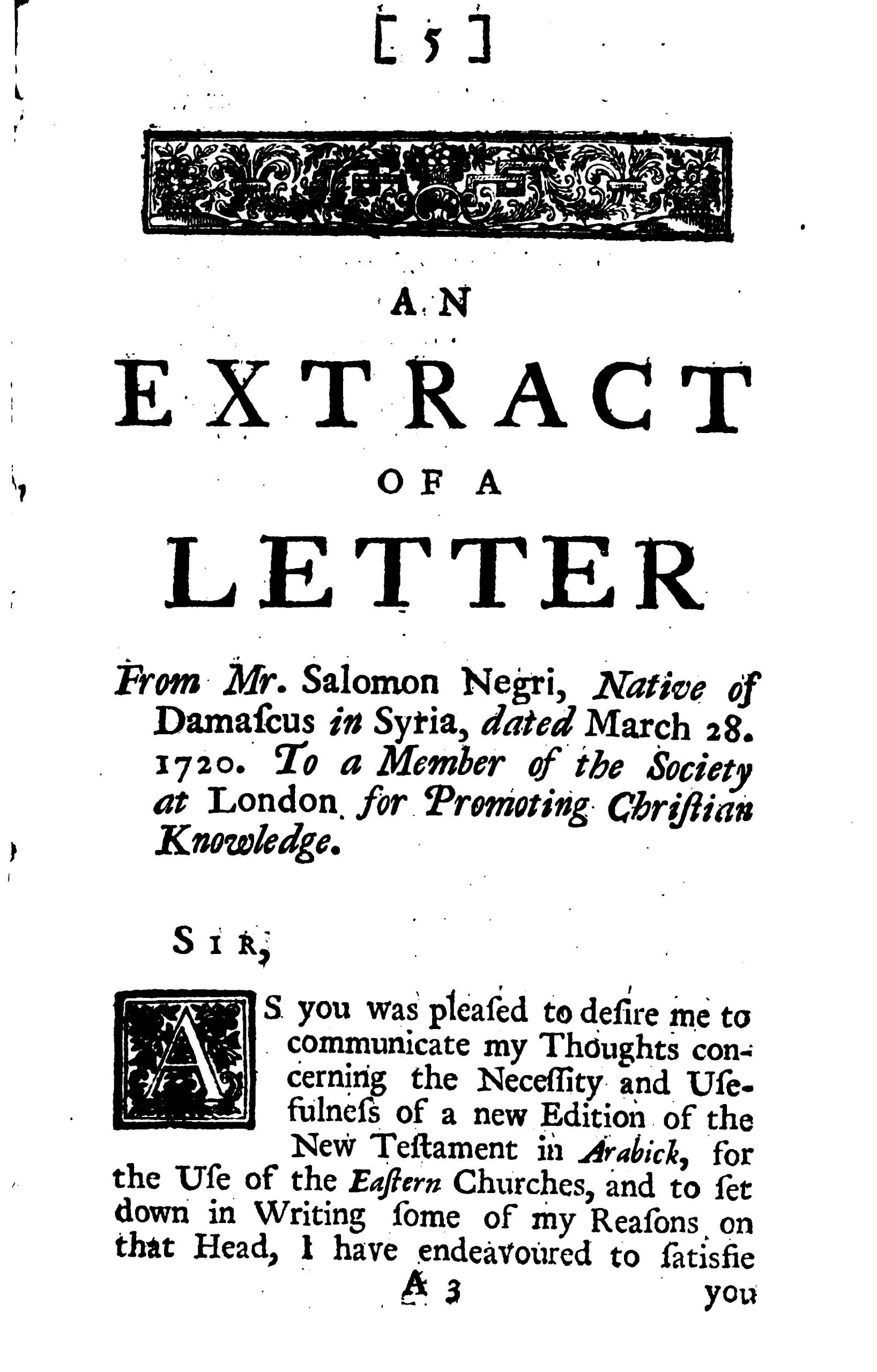
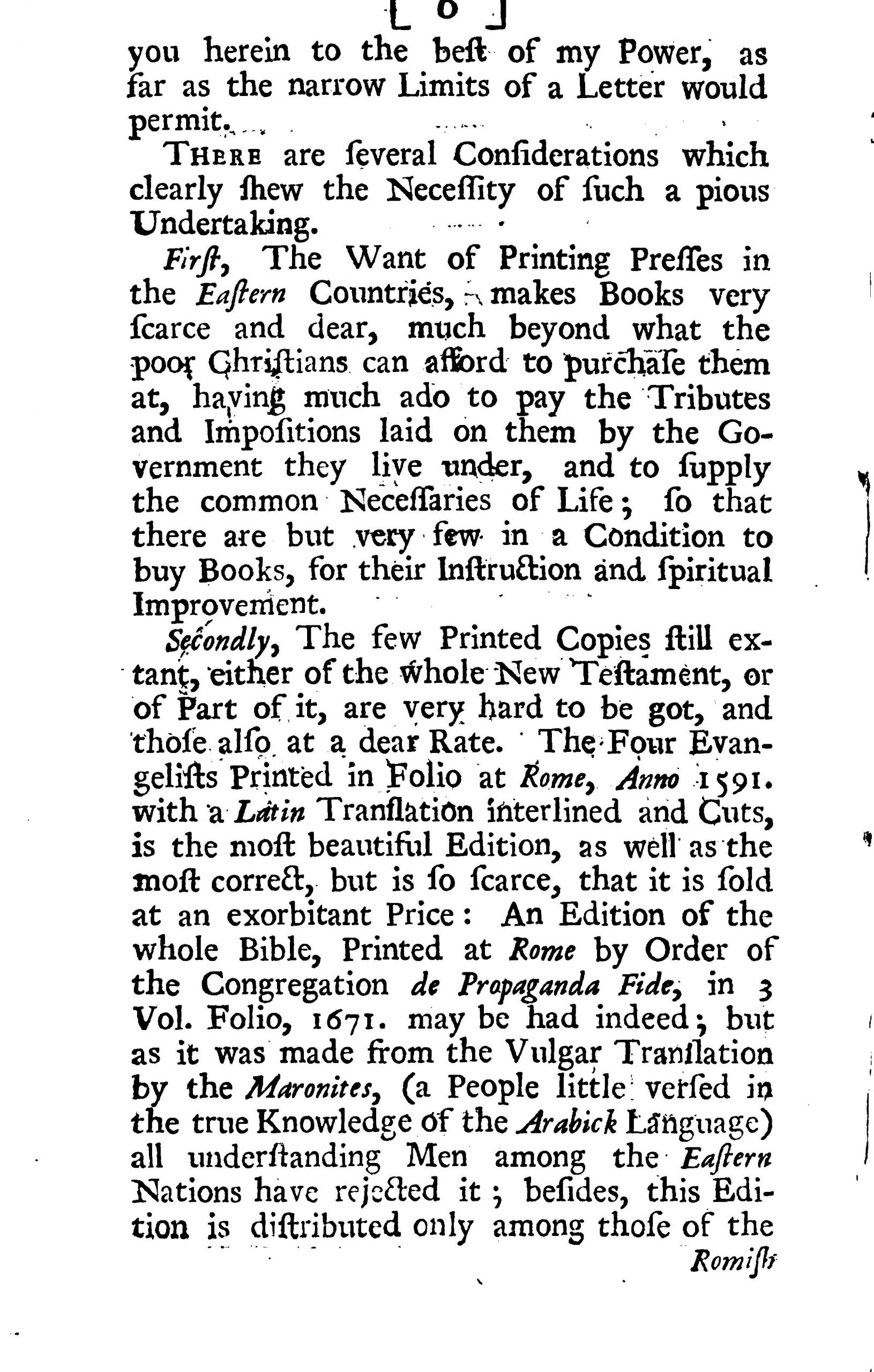
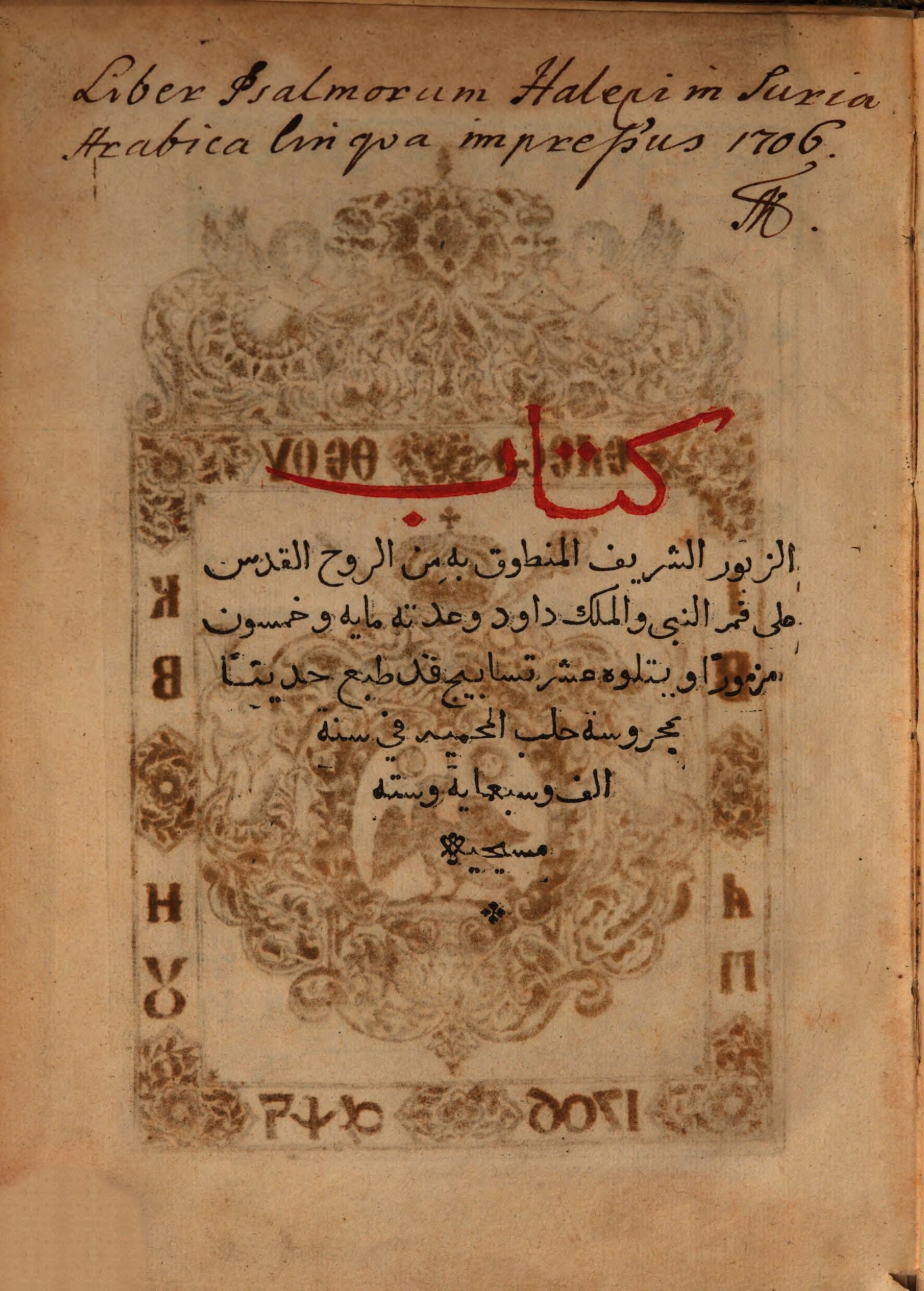
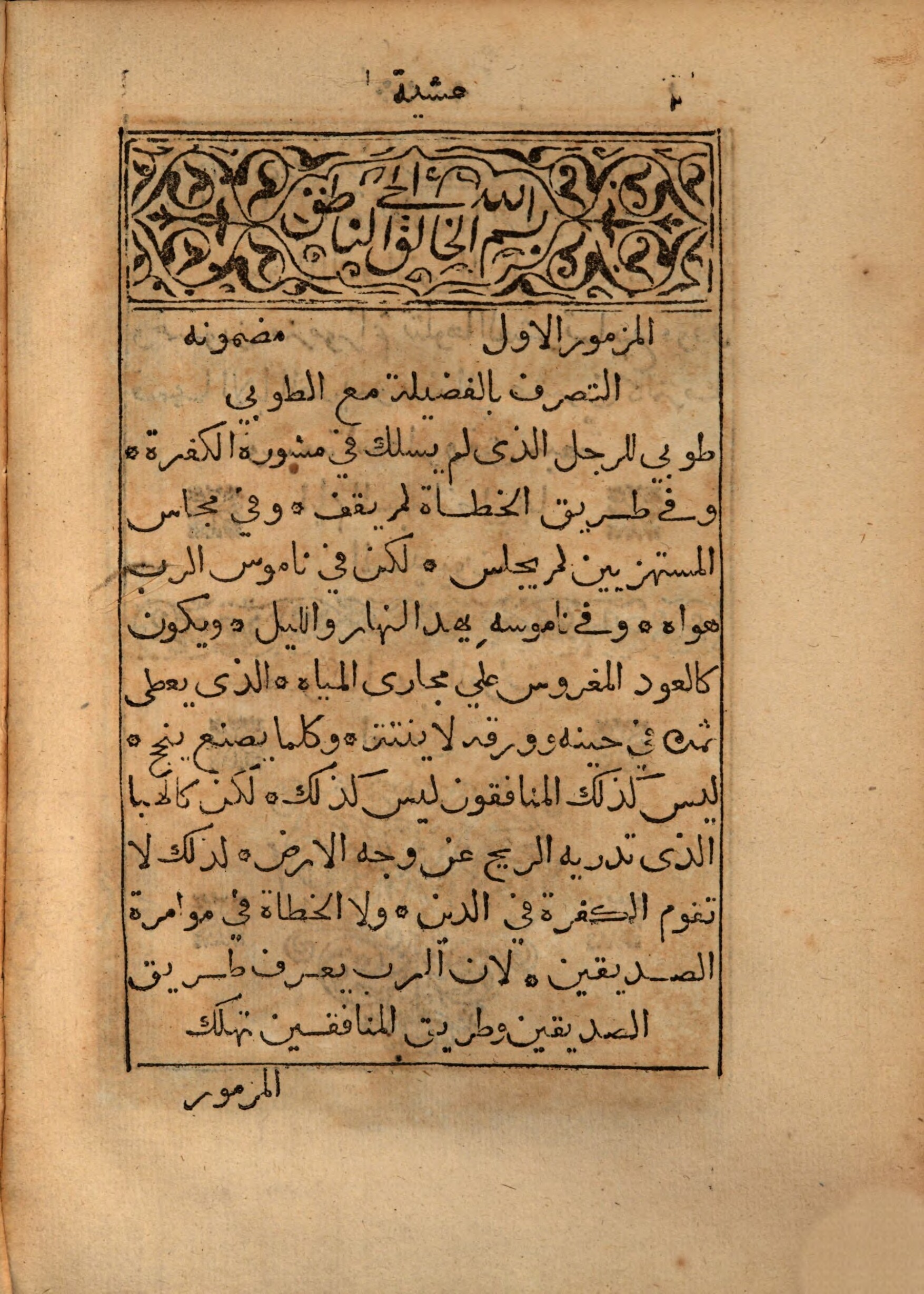

Leave a Reply